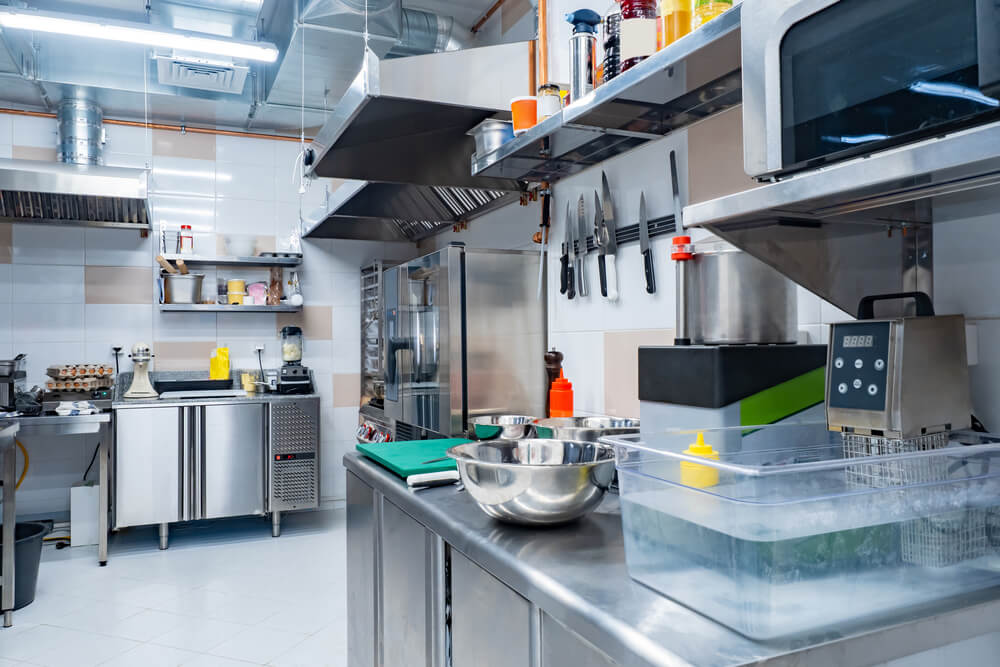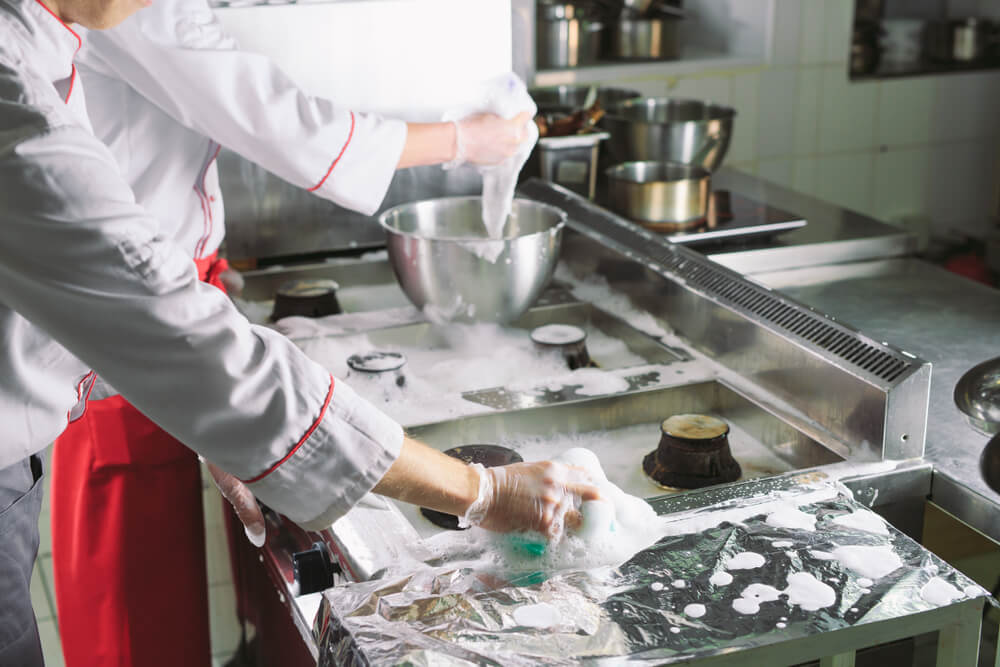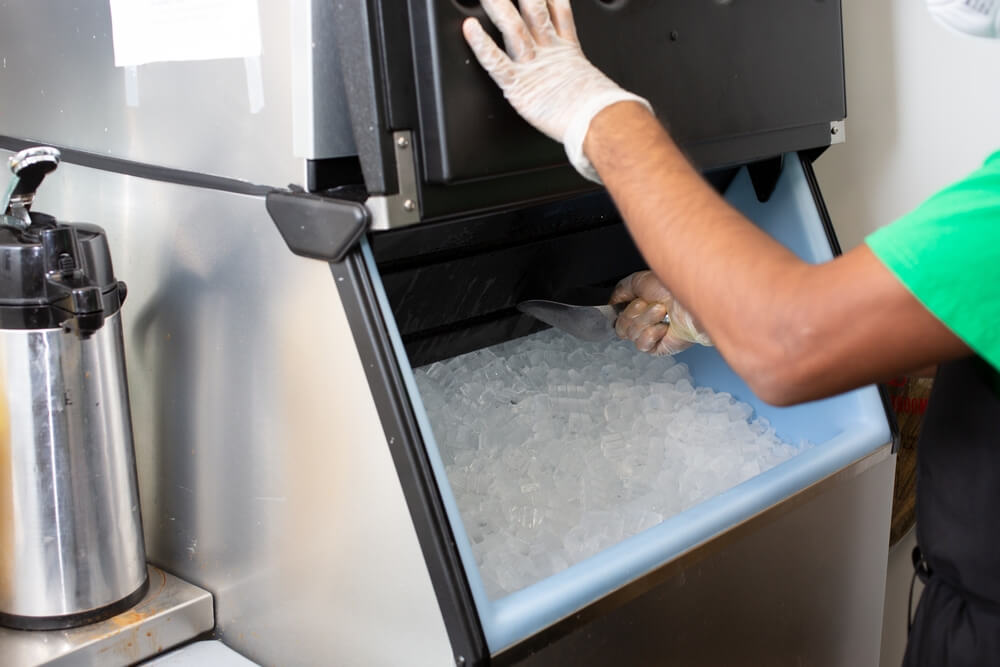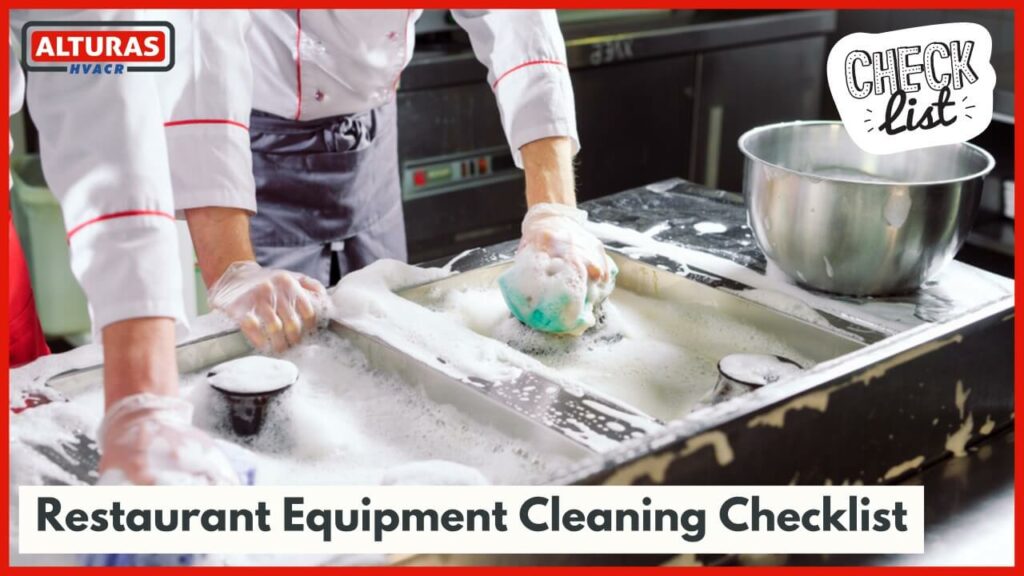Restaurant equipment cleaning and maintenance are of utmost importance if you run a food business or a food service industry. As restaurant kitchens emit an incredible amount of heat, pungent odor, and grease during the cooking process. All these emissions accumulate in kitchen equipment like exhaust hoods and refrigerators. Failure to deploy adequate restaurant cleaning procedures can result in fires and other catastrophes due to grease buildups.
Follow this quick and handy restaurant cleaning equipment checklist. There are some jobs that need to be done multiple times a day, while others should be performed weekly or monthly.
Restaurant Kitchen Items to Clean Daily
- Wash and sanitize all surfaces used in the cutting process like cutting boards, and the line and prep tables
- Wash your meat and cheese slicer after every use
- Brush the grills
- Empty sanitizing buckets
- Clean the fryers
- Make sure to empty your steam table and wipe it
- Cover your reach-in cooler bins with plastic wrap.
- Wash your kitchen floor mats
- Sweep and mop the kitchen floor
- Sweep the walk-in cooler
Restaurant Kitchen Items to Clean Weekly
- Clean coffee machines
- Empty your refrigerators, wash and sanitize them
- Sort leftover items in the fridge
- Clean outside of appliances
- Thoroughly disinfect the sink and clean faucets
- Clean inside the microwave
- Sanitize sponges and dust clothes
- Mop floors
- Replace dish towels with clean ones
Restaurant Kitchen Items to Clean Monthly
- Clean freezers and refrigerators from inside and wipe down shelves and drawers
- Wash behind ovens, stoves, and fryers to eliminate grease build-up, which can result in fire and other catastrophic
- Sort Inventory pantry items to know what’s outdated and what needs to be restocked
- Sort out the freezer items that need to be tossed, eaten soon, or restocked
- Use drain cleaner on floor drains
- Wipe down windows
- Clean inside of the dishwasher
- Clean the dish drainer drip pan
- Dust off decorations, wall hangings, painting, and artwork
- Clean and sanitize walls
- Empty and sanitize your ice machine
- Wash walls and ceilings of the kitchen to eliminate grease and food stains
- Wipe down all storage areas
Restaurant Kitchen Items to Clean Yearly
- Clean the kitchen hoods twice a year
- Check fire suppression systems and fire extinguishers
- Clean the pilot lights and burners on gas kitchen equipment
- Clean refrigerator coils (unplug your fridge first)
- Clean under the refrigerator
- Clean the interior of the oven
- Sort and organize cooking tools, like utensils pans, pots. Dispose of the duplicates and anything you haven’t used
- Dispose of the spices and supplements that are too old
- Look at all your crockery and repair or dispose of anything that’s broken.
Benefits of Commercial Kitchen Equipment Cleaning

Cleanliness of the dining area and kitchen, pleasant odor, and comfortable ambiance is the priority when a customer decides to dine out. If the kitchen and its equipment are not cleaned frequently, there are chances that a restaurant might lose its customers. It can badly affect the business as nobody wants to eat in a dirty place. Regular and proper cleaning of your commercial kitchen equipment increases its life expectancy and cooks food properly with a consistently great taste.
Your restaurant kitchen equipment works 24/7 and has a consistent supply of dirt, grease, and contaminated air flowing through it all day long. When layers of built-up grease and grime are removed, it
- Makes the unit run more efficiently
- Prevents grease fires
- Customer satisfaction ( no one likes a dirty atmosphere to eat in!)
- Enhances air quality
- Removes odor and grease from the kitchen
- Energy Efficiency
- Increases equipment life expectancy
- Lower temperatures
- Reduce the risk of health problems
- Reduces dampness
Restaurant Exhaust Hood Cleaning
Kitchen hoods are an essential part of any restaurant that helps ventilate the workplace and remove hazardous particles emitting from the stove. Unfortunately, many restaurants do not ensure proper cleaning of their restaurant hood. Therefore, with its continuous and excessive use, grease accumulates in the exhaust hood causing an increased risk of fire, improper ventilation, and even unpleasant odors in your kitchen.
Learn about HVAC Maintenance Services in Los Angeles
Restaurant Hood weekly cleaning

Clean the hood
Stainless steel hoods should be washed on a regular basis using a clean cloth. Start cleaning in the direction of the polish lines. Rinse with clear water and immediately wipe dry. Avoid using harsh or abrasive detergents
Clean the grease filters
Remove the filters and dip them into a warm cleaning solution. Slightly scrub the filters with a soft brush to remove the stuck dirt or you can also wash Aluminum mesh grease filters in your dishwasher every month if there is excessive usage. Use a non-phosphate detergent, soap, and water. Using phosphate detergents may cause discoloration of the filter.
Clean the grease traps
Remove the grease traps from the range hood. Make a cleaning solution using a degreaser and soak the grease traps in the solution. Using a non-abrasive scrubbing brush, scrub any remaining grease from the traps. Allow the grease traps to air dry before re-installing them in the kitchen hood.
Monthly cleaning
Clean the grease buildup in the duct
The exhaust ducts get messy while running a commercial kitchen. The Grease build-up in the air ducts can be a big problem as it blocks the air. An aerosol degreaser should be used to wipe the grease every now and then. It is recommended to call an HVAC specialist to come and inspect the exhaust duct.
Change the filter
A significant part of exhaust system maintenance is to change the filter regularly. A kitchen exhaust fan accumulates a lot of dirt and grease to expel cooking vapors and steam from a commercial kitchen. It’s important to change the exhaust filters whenever needed otherwise just removing grease from your exhaust fan won’t make any difference in the overall performance.
Restaurant Refrigeration cleaning

Daily cleaning
- Do a thorough Internal/ External Cleaning of the refrigerator daily to clean any Blockage by debris that can cause a strain on the unit, Use a soft brush or a vinegar solution, and scrub the shelves and compartments with warm water.
- Accumulation of moisture inside the shelves or the reach-in units can cause your refrigerator to freeze up over time, thereby inhibiting its overall performance. Make sure to wipe off any spills of water in the unit regularly.
Monthly cleaning
- Dirt and debris build-up if the refrigerator is placed near air fryers or stoves obstructing the flow of heat through the coils. Clean the Coils with a commercial condenser coil cleaner, or an air compressor. It is recommended to get it done by a refrigerator service specialist to avoid any damage to sensitive coil fins.
- Inspecting the gaskets for any cracks, gaps, or tears in a commercial refrigerator from time to time is inevitable to prevent the refrigerator from becoming non-functional. Check and clean the gaskets and door hinges and lubricate them to ensure a tight seal of the refrigerator’s doors.
- Dirt and grease from kitchen fryers and stoves can accumulate on the fan blades in a commercial refrigerator, thereby hindering air ventilation and slowing down the motor. Use a degreasing solution to eliminate the grease every now and then.
- Commercial refrigerator drain lines get clogged every now and then due to slime and clag. Cleaning the pan regularly is inevitable to maintain the performance of the refrigerator and avoid any significant blockage.
Commercial Ice Machines Cleaning

Weekly cleaning
- Wipe surfaces of the ice machine with the cleaning materials like a damp cloth to remove dust and dirt from the outside of the ice machine.
- Clean any grease that remains after cleaning, use a damp cloth rinsed in a mild dish soap and water solution. See your machine’s manual for restrictions.
Commercial Ice Machine Cleaning Tips
Monthly cleaning
- Turn off the power supply and Drain Water
- Remove the ice before the cleaning and sanitizing process. Make sure the appliance is unplugged before you begin to clean your ice machine
- Once the ice falls, remove the ice. and drain the remaining water out of the appliance.
- Press the “clean” or “wash” button, and water will flow across the water dump valve and down the drain. Wait until the water trough refills and the display shows an indication to add chemicals. This typically takes at least 1 minute.
- Add ice-machine cleaner. Wait until the cleaning cycle is complete.
- Before cleaning, remove the internal components from your ice machine. refer to your machine’s manual to remove it properly.
- Remove the replaceable components of your ice machine. Dilute water into the cleaner mixture and clean the components. Use a soft-bristle nylon brush, sponge, or cloth to carefully clean all parts
- Once all the components have been removed, wipe the interior of the ice maker including all the food zone surfaces of the ice machine. Use a soft cloth and warm soapy water, to thoroughly clean areas like side walls, base, evaporator plastic parts, and the bin or dispenser.
- Once you’ve cleaned the inner surface, make sure to rinse all areas and components with clean water. This will remove chemicals and prevent ice from becoming contaminated.
Restaurant Kitchen Equipment Cleaning services near me
If you don’t have the proper equipment and tools for the cleaning and maintenance work of the restaurant kitchen equipment, it is always recommended to call a professional commercial kitchen maintenance and cleaning expert to your place and get a thorough inspection.
Alturas Contractors are successfully providing cleaning and maintenance services in Los Angeles and California. We offer not only design and installation but also kitchen equipment cleaning services so you may focus on your business rather than equipment upkeep. Our Los Angeles HVAC Contractors work around your schedule. Follow this handy restaurant equipment cleaning procedure checklist to ensure your restaurant is spick and span, passing all health and safety inspections!

